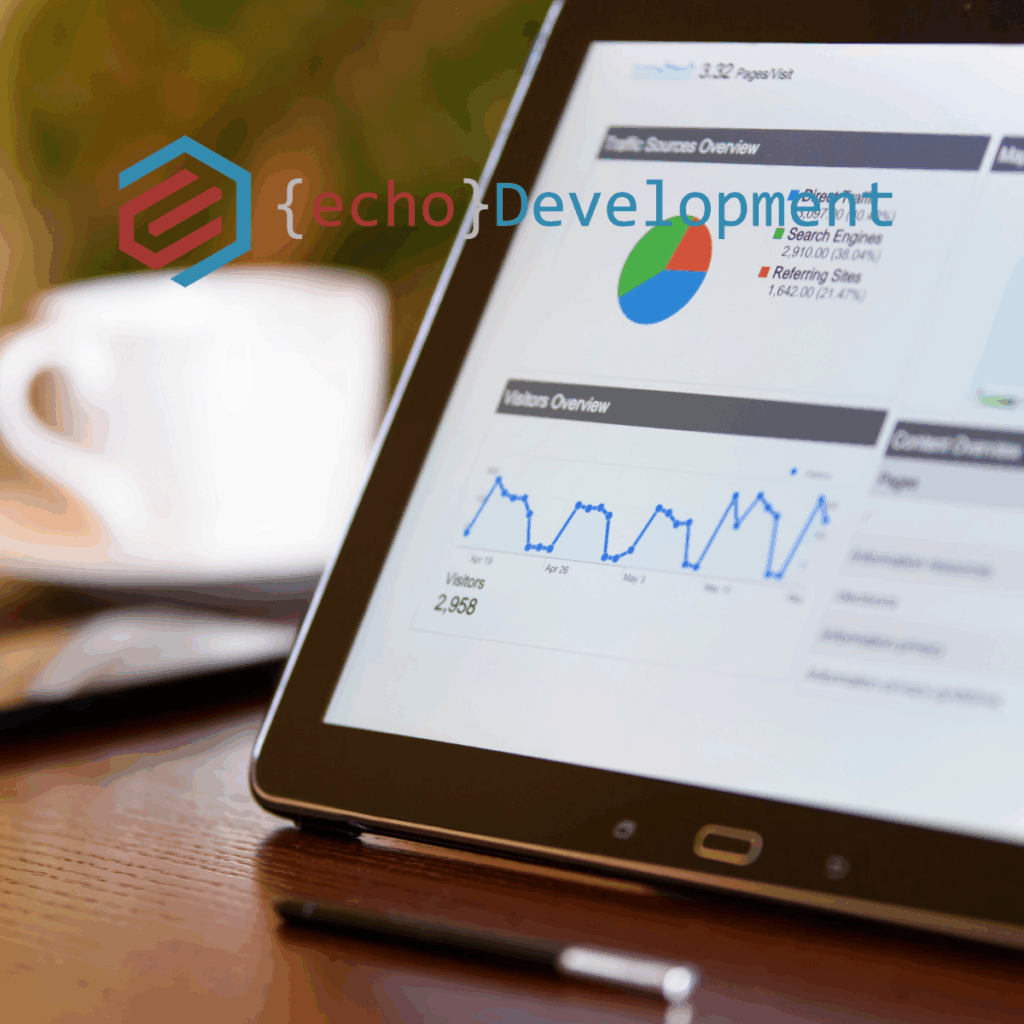In today’s digital age, how and where you store your data is as critical as what data you collect. For UK businesses especially, understanding the implications of the UK GDPR (and the supporting Data Protection Act 2018) is essential — particularly when it comes to data residency and system architecture decisions. At echodevelopment.io, we help clients move from spreadsheets and paper‑based systems into web‑based, secure, fully compliant platforms. In this article, we’ll explain why where your data sits matters, what risks you face if you don’t get it right, and how a bespoke solution can give you the time, efficiency and peace of mind your business deserves.
1. The legal framework: UK GDPR and what it means
The UK GDPR is the UK’s domestic data‑protection regime, retained after Brexit and working alongside the Data Protection Act 2018. ICO+2GOV.UK+2 It sets out principles such as lawfulness, fairness, transparency, purpose limitation, minimisation, accuracy, storage limitation, integrity and confidentiality, and accountability. ICO+1
While the UK GDPR does not explicitly say “data must be stored in the UK”, there are two linked considerations:
Thus, simply storing data on a cheaper overseas server — even if the provider is perfectly functional — may create compliance risk unless you can demonstrate the safeguards and legal basis for that transfer.
2. Why server location and architecture matter (even if the law doesn’t say “must stay in UK”)
Although there is debate about the strict requirement of UK‑only storage, many organisations misunderstand or underestimate the risks of hosting data outside the UK or on shared, low‑cost global infrastructure. A blog by TechGDPR explains how “data residency” (where the infrastructure sits) and “data sovereignty” (legal control) matter. TechGDPR
Some of the practical implications:
3. Real world business risk of using cheap overseas providers
Here are some of the risks to your business if you choose a low‑cost non‑UK host or generic cloud service without bespoke design:

4. How moving from spreadsheets/paper to web‑based, UK‑hosted bespoke system helps
At echodevelopment.io we specialise in bespoke software solutions tailored to your business needs: moving you away from spreadsheets and paper, consolidating your data into one central place, giving you robustness, redundancy, compliance and clarity. Here’s how that helps:
5. Key questions your business should ask a software provider
If you are engaging a software partner (or thinking of switching from spreadsheets/legacy systems), ask these questions to ensure you remain compliant and efficient:
6. Summary and call to action In summary: Yes, storage location does matter. While the UK GDPR does not simply say “all data must be stored in the UK”, it does impose duties around transfer, safeguards, security, auditability and accountability. If your provider is using cheap overseas hosting or generic cloud services with minimal transparency, you are exposing your business to compliance, operational and reputational risk.
Visit www.echodevelopment.io Contact us for a free consultation.
In today’s fast‑moving business world, the humble spreadsheet — once a trusted tool — can actually become a liability. If you’re still relying on spreadsheets and paper for your key processes, you might be wasting time, facing unnecessary risk and limiting your growth potential. At echodevelopment.io we help businesses step out of that old world and into a streamlined, secure, web‑based system built just for them.
Spreadsheets are cheap, familiar and flexible. That’s why they’ve survived for so long. But as your business grows, their drawbacks become glaring:
The result is often wasted time, increased risk, frustrated staff and processes that don’t help your business grow.
When you partner with us at echodevelopment.io, you’re not just buying software — you’re commissioning a system crafted for your business. Here’s what that looks like:
If your business is regulated, subject to standards like ISO, or part of an awarding body—or if you simply care about processes, data integrity and audits—then the benefits multiply.
Take the case of organisations using a system like MYISOSYSTEM. They’ve realised that by automating their ISO‑compliance workflow, moving away from manual spreadsheets and harnessing a secure system for documentation and task tracking, they gain far more control and far less stress. LinkedIn+1
We at echodevelopment.io can build an interface or integration that makes such systems work seamlessly in your environment — reducing audit preparation time, cutting error rates and providing the transparency your auditors will love.
Here are just some of the up‑front benefits our clients experience:

Here’s a quick overview of how we work:
At echodevelopment.io we live the mission: “deliver bespoke software solutions that optimise efficiency and functionality, guided by trustworthiness, integrity and innovation.”
We’re not a massive firm; we’re a small‑scale software house where you matter, your business matters, and we commit to building something meaningful in your life. Our clients don’t just buy a system — they gain more time, more redundancies, better organisation and longstanding peace of mind.
If you’re ready to move beyond spreadsheets and paper. If you’re ready for a system that works for you, not the other way around. If you’re ready to centralise your business information, improve security, reduce risk, and give yourself the time back… then let’s talk.
Visit echodevelopment.io to book a call, share your challenges and see what’s possible. In the meantime – ask yourself: how many hours did I waste last week on manual admin? What if you could reclaim them?
Ever feel like your business would fall apart if you stepped away?
If you’re constantly the one fixing the formulas, hunting down the right version of a spreadsheet, or being asked “where’s that file?” — then you’re not just running the system…
You are the system.
And that’s a problem.
At first, it feels efficient. You know how things work. You’ve built the processes yourself.
But as your team grows and compliance demands rise, this model becomes a risk.

That’s where echodevelopment.io come in
We build web-based systems that take what you’re doing manually — in spreadsheets, notebooks, or your brain — and turn it into something shareable, secure, and scalable.
Whether it’s ISO compliance, approvals, or everyday workflows, we help you:

One client came to us after realising they were the only person who could prep for audits.
Every year, it was the same story — late nights, stress, and a mad scramble.
We built them a central, role-based compliance platform. Now:
You don’t need to be the system anymore.
You just need the right system.
If you’re ready to build one that works — even when you’re not around — get in touch with echodevelopment.io today.
Let’s turn your knowledge into software that empowers your whole team.
If you’ve ever found yourself scrolling endlessly through a spreadsheet, desperately searching for a cell with the “right” data, you’re not alone. Businesses across industries have relied on Excel for decades—it’s familiar, flexible, and, at first, it gets the job done. But as your operations grow and compliance requirements become more complex, that once-reliable spreadsheet can quickly turn into a source of frustration, wasted time, and compliance risk.
That’s where bespoke PHP software comes in—especially in the ISO and compliance space. At echodevelopment.io, we specialise in transforming your existing spreadsheets into secure, web-based systems that are built exactly to your needs. This isn’t about replacing your process; it’s about supercharging it.
Spreadsheets are a fantastic tool for early-stage data management. But as compliance frameworks such as ISO 9001, ISO 27001, and GDPR evolve, they require more than just “good enough” tracking.
Here are the common pain points:

When compliance is critical, “good enough” is no longer enough.
A bespoke PHP solution offers the perfect combination of flexibility and security for ISO and compliance-heavy industries. Unlike off-the-shelf software, a custom-built system is tailored to your exact workflow, eliminating unnecessary features while enhancing the functions you actually need.
Key Benefits:
And because PHP is incredibly versatile, your system can scale as your compliance requirements grow.
We know your existing spreadsheets are more than just “numbers in boxes.” They represent years of refined processes, checklists, and compliance history. That’s why we don’t throw them out—we build on them.
Here’s our proven process:
By keeping your process at the heart of the system, you get a familiar yet more powerful way to manage compliance.
One client came to us with 15 Excel files for tracking quality management processes under ISO 9001. The files were shared across email, Teams, and memory sticks—making version control nearly impossible.
We built them a central compliance portal where:
Within three months, audit preparation time dropped by 80%, and the client’s stress levels dropped even more.
Compliance isn’t optional—it’s a business-critical requirement. The consequences of missing deadlines, losing records, or submitting inaccurate data can be severe. That’s why ISO and compliance-heavy businesses gain the most from a tailored approach.
Bespoke PHP systems can be designed to meet specific compliance frameworks, such as:
Instead of trying to “make do” with generic compliance tools, your business can have a system built to match your certification, your workflows, and your industry requirements.
When you move from spreadsheets to a bespoke web system, you’re not just solving today’s problem—you’re future-proofing your business.
Spreadsheets will always have their place—but in the world of ISO and compliance, they’re a starting point, not a final solution. A bespoke PHP system gives you security, control, and efficiency, turning compliance from a time-consuming chore into a streamlined, stress-free process.
If you’re ready to take your spreadsheets and turn them into a centralised, compliant, and secure system, echodevelopment.io is here to help. We specialise in bringing your processes online—without losing the personalisation that makes your business unique.
When most people hear the phrase “Multi-Factor Authentication (MFA),” they immediately think of frustration—endless codes, awkward logins, and having to explain it repeatedly to staff.
But here’s the truth: MFA doesn’t have to be hard. And when done right, it can be the key that protects your business from preventable breaches—without grinding your workflow to a halt.
At EchoDevelopment.io, we’ve spent years working with clients who live and breathe compliance. ISO Consultants, Certification Bodies, and Awarding Organisations—all of whom face the delicate balance of enforcing strong security while keeping systems usable.
We’ve talked before about PHP security, encrypted data layers, and the importance of safe hosting. But all of that can be undermined by one weak password.
MFA is your frontline defence. Even if a password is stolen or guessed, MFA ensures the attacker still hits a wall. But only if it's implemented well.
Many systems bolt on MFA as an afterthought. It’s clunky. It breaks during updates. It leaves users locked out—or worse, makes them bypass it entirely just to get work done.
Clients told us stories of:
Security should never punish the user.
We build systems that consider the user first, and security second—not the other way around.
With our platforms (including MyISOSYSTEM and bespoke portals for Awarding Bodies), MFA is seamlessly integrated:
And we support this with intuitive UX, so it feels like part of the platform—not an extra obstacle.
A recent client—a regional awarding body—came to us after their existing system failed an internal security audit. They had no MFA, shared logins, and little traceability.
Within three weeks of onboarding with us:
The best part? They didn’t receive a single complaint about the new system.
Every system we build—whether for a one-person consultancy or a 100+ user body—is designed to:
If you’re relying on passwords alone, or still manually managing access, it’s time to rethink security.
Let’s make it simple, together.
Want to see how we can secure your systems without disrupting your workflow?
Send us a message. Or tag someone who needs to read this.
In the world of software development, PHP has long been a staple. From powering simple websites to driving large-scale web applications, its flexibility has kept it relevant across decades. But what keeps PHP thriving in 2025 isn't just familiarity—it's innovation.
Recent updates to PHP and the evolving ecosystem of security protocols offer new opportunities—and raise the bar—for what businesses should expect from their digital systems. For teams like ours at echodevelopment.io, these advancements are not just welcome; they're essential.
In this post, we’ll unpack what’s new in PHP, how security protocols have advanced, and what it all means for you as a business owner.
With the release of PHP 8.3, we’ve seen both performance and syntax improvements that streamline development while enforcing cleaner code. Key highlights include:
These enhancements don’t just make life easier for developers—they improve the integrity and maintainability of the systems we build.
Security has shifted from being a reactive layer to a proactive discipline. We now build with a "zero trust" mindset, meaning every request, every interaction, and every piece of data must be validated, encrypted, and monitored.
Here’s what’s shaping best practices today:
Security is not an afterthought—it’s a foundational element in every system we create. Here’s how we integrate modern PHP practices and security standards into your bespoke solution:
If your systems are still running on outdated versions or patchwork plugins, the risks are significant. Data breaches, downtime, and legal non-compliance are just the start.
With the rise of ransomware, phishing, and supply chain attacks, the question isn’t if your systems will be tested—but when.
What makes our clients sleep better at night is knowing their systems are:
PHP is evolving—and so are the threats. The good news is, businesses don’t need to become cybersecurity experts. You just need a partner who already is.
If you're still relying on Excel, outdated CMS tools, or pre-built templates, now’s the time to rethink your strategy. At echodevelopment.io, we bring together secure architecture, bespoke logic, and modern UX to help you grow without compromise.
In recent weeks, two major UK household names—Marks & Spencer (M&S) and the Co-operative Group (Co-op)—have found themselves in the crosshairs of cyberattacks. While exact details of these breaches are still emerging, what’s already clear is the profound ripple effect they’ve caused—not only for the businesses involved but also for millions of customers whose data may now be at risk.
At EchoDevelopment.io, we’re not here to criticise companies facing such challenges. We understand the pressure, the complexity, and the evolving threat landscape that businesses of all sizes must navigate. Instead, we want to reflect on what these events mean, show empathy to the companies impacted, and reinforce the importance of making cybersecurity a foundational part of software development.
When trusted institutions like M&S and Co-op experience data breaches, it shakes public confidence. These brands are not just retail chains—they are pillars in British society. Families, employees, and suppliers all rely on them. That’s why the emotional and practical impact of these attacks runs deep.
For customers, the anxiety is immediate: Was my personal data exposed? Could I become a victim of fraud or identity theft? And for employees, the aftermath often involves long hours, damaged reputations, and scrambling to reassure stakeholders.
We don’t downplay the scale or sensitivity of these incidents. Cyberattacks can feel like a personal violation. That’s why our first instinct is not to point fingers, but to extend support and solidarity.
These hacks serve as a stark reminder that even the most well-established organisations are not immune to cyber threats. The implications go far beyond IT systems:
If your customers don’t feel safe, they will take their business elsewhere. And in today’s digital-first world, trust is often your most valuable currency.
At EchoDevelopment.io, we work with businesses that rely on digital infrastructure to function, grow, and serve their clients. Whether we’re building bespoke software, client portals, ISO compliance systems, or cloud platforms, security is baked into every single layer.
Here’s how we take cybersecurity seriously:

Security isn’t a checklist; it’s a culture. And that culture is embedded into every project we deliver.
Many businesses, especially SMEs and certification bodies, assume they’re “too small” to be targeted. The reality is the opposite—small and mid-sized organisations are often seen as easier targets.
That’s why our approach always involves:
We empower our clients not just to protect their business, but to future-proof it.
To the teams at M&S and Co-op: we empathise. We know the toll an incident like this can take on an organisation, its leadership, and its people. We hope for a swift recovery and stronger systems in the aftermath.
To everyone else—whether you’re running a local business or managing a national body—let this be your reminder that security can’t wait. Your customers, your reputation, and your long-term survival depend on it.
If you’re unsure where your vulnerabilities lie or you know your systems need an overhaul, let’s talk.
We’ll meet you where you are—and take you where you need to be.
In our previous blog, we explored how continuous integration, automated testing, and post-deployment monitoring elevate software reliability and performance. This month, we’re taking it even further by looking at how DevOps and Quality Assurance (QA) come together to build software that’s not just functional, but continuously improving.
Quality as a Culture
In traditional models, QA was often siloed—brought in at the end of development to catch bugs. But in a DevOps-driven environment, quality is a shared responsibility. Every developer, tester, and operator plays a part in ensuring software runs smoothly from development to deployment.
At echodevelopment.io, we embed quality across the entire DevOps lifecycle. This means testing doesn’t just happen once—it’s part of every build, every change, every deployment.
Integrating QA into the DevOps Pipeline
To deliver high-quality software rapidly, we integrate testing into each stage of the CI/CD pipeline:
This approach creates a feedback loop that helps us detect, respond to, and resolve issues faster—reducing downtime and improving user satisfaction.
Tools and Technologies We Use
We leverage powerful tools to automate and enhance QA in DevOps:
These tools help us maintain code quality, reduce manual effort, and speed up delivery timelines without sacrificing reliability.
The Business Benefits
Embedding QA into DevOps pipelines results in:
Conclusion
Quality isn’t just an afterthought—it’s a continuous, collaborative effort. By combining DevOps practices with proactive QA, echodevelopment.io delivers secure, scalable, and high-performing solutions that evolve with your business needs.
Looking to embed quality into your development process? Let’s build something great together. Contact us today at echodevelopment.io.
In last month’s blog, we explored the importance of Testing and Quality Assurance (QA) in custom software development, diving into methodologies that ensure robust, secure, and high-performing software. This month, we take it a step further by focusing on continuous integration, automated testing, and post-deployment monitoring—three key elements that elevate software quality and ensure long-term success.
Continuous Integration (CI) is an essential practice in modern software development, where developers frequently integrate their code into a shared repository. With each integration, automated tests run to catch errors early, making it easier to resolve issues before they escalate. At Echo Development, we leverage CI to ensure:
By implementing CI, we streamline the testing process and ensure that all new code changes work seamlessly with existing software.
Automated testing is a game-changer when it comes to quality assurance. Rather than relying solely on manual testing, automated tests allow for quicker, more efficient validation of functionality across different environments. Some benefits include:
At Echo Development, we use tools like PHPUnit for PHP-based applications, Selenium for UI testing, and JMeter for performance testing to ensure software stability and resilience.
Software development doesn’t stop at deployment—monitoring plays a crucial role in maintaining software quality. Post-deployment monitoring includes:

By implementing proactive monitoring strategies, we minimize downtime, improve security, and enhance the user experience.
Testing and QA are ongoing processes that don’t just ensure a smooth launch but also guarantee long-term software reliability. By integrating continuous testing, automation, and post-deployment monitoring, businesses can reduce costs, improve security, and enhance user satisfaction.
Looking for expert QA solutions for your business? At Echo Development, we ensure your software remains secure, scalable, and error-free. Contact us today at echodevelopment.io and let’s build something extraordinary together.
In today’s fast-paced digital landscape, custom software development is more than just writing code—it’s about delivering high-quality, reliable, and scalable solutions that meet business needs. One of the most critical phases in this process is Testing and Quality Assurance (QA). Without a rigorous QA strategy, even the most innovative software solutions can fail due to bugs, performance issues, and security vulnerabilities.
At Echo Development, we prioritize QA at every stage of software development to ensure that our solutions not only meet but exceed client expectations. In this blog, we’ll explore the importance of testing and QA, the methodologies we use, and how businesses can benefit from a robust quality assurance strategy.
Software development is a complex process that involves multiple moving parts—from backend logic and database management to frontend design and user experience. Each of these components must work seamlessly together. Here’s why QA is an essential part of this process:
1. Enhancing Reliability and Performance
Nothing frustrates users more than buggy or slow applications. Rigorous testing ensures that all features function as expected, minimizing downtime and improving performance. We use performance testing to simulate real-world conditions, ensuring that our software scales effectively under different levels of demand.
2. Ensuring Security Compliance

Cybersecurity threats are a growing concern for businesses of all sizes. Security testing helps identify vulnerabilities before hackers can exploit them. At Echo Development, we integrate security testing into our QA process, ensuring that sensitive user data remains protected.
3. Cost-Effective Development
Fixing software defects early in the development cycle is significantly cheaper than addressing them after deployment. A well-structured QA process prevents costly post-release fixes and helps maintain customer satisfaction.
4. Delivering a Superior User Experience
A smooth, intuitive user interface is key to customer retention. Usability testing ensures that applications are user-friendly and free from functionality issues that could impact customer satisfaction.
At Echo Development, we employ a multi-layered QA strategy to guarantee software excellence. Our approach includes:
We leverage automated testing tools such as PHPUnit and Selenium to streamline the testing process. Automated testing allows us to quickly detect regressions and validate core functionalities without manual intervention, saving time and increasing efficiency.
While automation is essential, manual testing plays a crucial role in identifying issues related to usability, aesthetics, and unexpected edge cases. Our testers put themselves in the user’s shoes to ensure the software meets real-world demands.
We follow an Agile development approach, incorporating continuous testing throughout the development lifecycle. This means our software is tested iteratively, allowing us to catch and resolve issues early.
Using tools like JMeter, we simulate high user loads to measure system performance and identify potential bottlenecks. This ensures our solutions remain responsive under peak demand.
A robust QA strategy does more than just reduce defects—it enhances brand reputation, improves customer satisfaction, and increases operational efficiency. Companies investing in quality assurance experience fewer software failures, stronger security compliance, and higher ROI on their software investments.
Are you looking for a reliable partner to develop high-quality custom software tailored to your business needs? At Echo Development, we combine cutting-edge technology with a rigorous testing process to deliver robust, scalable, and secure solutions. Let’s build software that drives your business forward.
Contact us today at echodevelopment.io to discuss your project and see how our expertise in PHP and quality assurance can transform your business